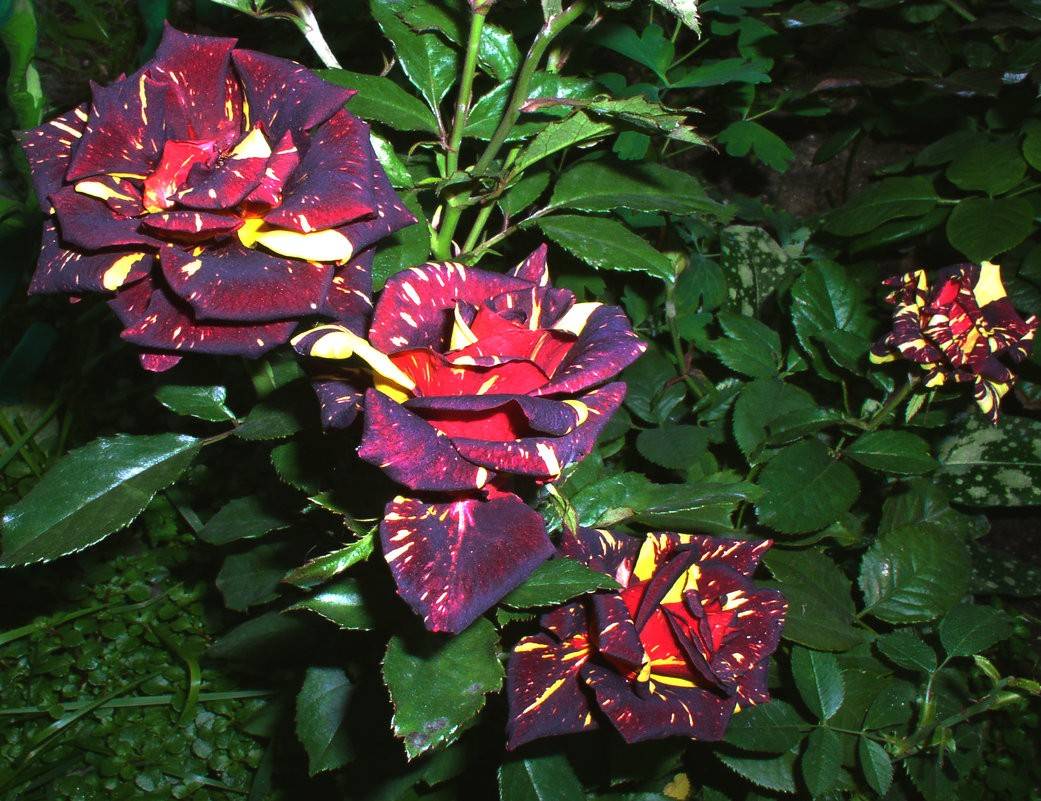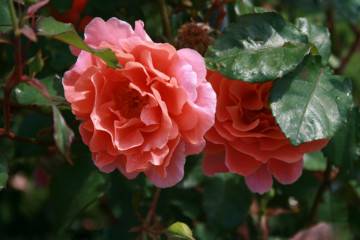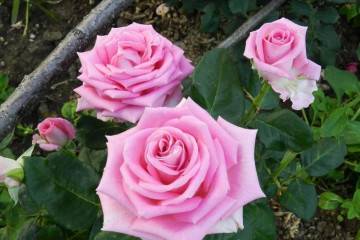Rose Abracadabra
Content:
The unusual color of the petals of the Abracadabra rose invariably evokes a violent reaction from those who first saw it. A combination of shades of scarlet, lemon, chocolate and white - all in one flower.
Rose Abracadabra (Abracadabra) - what is this variety
In stores, you can find, in addition to the usual hybrid tea Abracadabra, two more of its varieties: Floribunda Kordes 2002 and 2004. The first is the first sample of selection, bred in 1991 by W. Warriner (USA). The work was based on White Masterpiece and Tribute repair and tea roses. The public liked the rose so much that W. Kordes & Sons (Germany) based it on two variations, using an additional similar variety Hocus Pocus.
Short description
The variety belongs to the hybrid tea group. The bush is formed upright or spreading. Gardeners practice growing on a stem with a height of 50-150 cm. Dark green stems are covered with thorns, at the ends of a single bud or brush. A double flower in diameter from 8 to 12 cm. The petals are velvet pointed.
The color of the buds is very interesting. Represents asymmetric spots, strokes, stripes and points of brown, red, yellow, white, purple, burgundy shades. The aroma is noticeable and very pleasant.
Advantages and disadvantages of the variety
The advantages of the variety are:
- originality of color;
- winter hardiness up to −23 ° С, which is the norm for a cut-off variety;
- powdery mildew resistance;
- undemanding to the composition of the soil;
- in the cut costs up to 16 days.
Among the shortcomings, there is a weak resistance to rain and drought.
Use in landscape design
In the design of parks, the Abracadabra rose is used in combination with conifers. The combination with monochromatic varieties of climbing roses looks beautiful, shading its bright color. Fruit and ornamental shrubs are planted at a distance of at least 1.5 m.
Growing a flower
Subject to the key rules of agricultural technology, the shrub will certainly take on a new place and demonstrate everything that it is capable of.
The seedlings are purchased from nurseries and garden centers, where supplies are made from the Kordes branded network. Given that the tea hybrid does not produce full-fledged seeds, seed sowing for reproduction is impossible, only by grafting.
Autumn planting shows the best results. Time is selected depending on the climate, counting 3 weeks to the next frost. At this moment, the leaves are already preparing to fall off, but the roots are still active enough to start growing in a new place.
Seat selection
Preference is given to open areas on a small hill, well-blown. This is a prerequisite, since the resistance to fungal diseases in this rose is low. If the planting is carried out in the southern region, then a place is chosen in partial shade so that sunburn does not appear on the petals.
How to prepare the soil and flower for planting
Black earth is ideal, but loam is also good, as long as the groundwater level is low enough. Acidity range pH = 5.6-7.3. On acidic soils, preliminary liming is required, and peat is added to clay soils.
Climbing rose Abracadabra for spring planting should only have dormant buds, and for autumn it may have foliage and even buds that will have to be cut off immediately. The root system of seedlings without shipping containers needs to be soaked for 6 hours.
Planting procedure step by step
Landing is performed as follows:
- Landing holes are dug to a depth of 50 cm and at the same distance from each other.
- A layer of 5-10 cm of drainage is poured onto the bottom (sand mixed with agroperlite, vermiculite or fine gravel, expanded clay).
- The soil is mixed with humus or compost, adding 40-50 g of superphosphate.
- The roots are lowered into the hole, deepening the root collar by 3-5 cm.
- Cover with soil and watered immediately.
- Mulch.
Plant care
Outdoors, Abracadabra care is similar to the standard for all tea hybrids.
Watering rules and humidity
The variety is resistant to drought, but it is not worth bringing the soil to dryness. It is quite enough to wait until the top layer of the soil dries up 3 cm deep, and then perform the next watering.
Top dressing and soil quality
The first organic fertilizers are applied when the buds are still sleeping. Compost or humus is mixed with the topsoil. Then, during the entire period of active growing season, potassium-phosphorus fertilizing is applied at intervals of 3 weeks.
Pruning and replanting
Formative and sanitary pruning is carried out in spring and autumn. In April, all the branches that have frozen over the winter, broken and damaged are cut off before the buds awaken. In the fall, shortly before frost, the shoots are shortened, removing unripe tops and remaining buds.
A rose transplant is not needed, but in the Middle Lane, where in winter the temperature drops below -30 ° C, it is practiced. The bush is dug out completely, the roots are lowered along with a lump of earth into a box of sand and placed in the basement, where the temperature is maintained at 4 ° C. In winter, periodically, the earth needs to be moistened.
Features of wintering a flower
Abracadabra can winter without shelter only up to -5 ° С. In other regions, she will need a shelter from an agricultural canvas or spruce branches. Cover immediately after pruning. So that dampness does not accumulate under the shelter, dry foliage is poured inside.
Blooming rose
In summer, the rose blooms with short interruptions if it is planted in open ground. In a greenhouse or greenhouse, buds appear continuously.
Periods of activity and rest
The first buds bloom in June, and the last ones in early September. But this happens only in flower beds and flower beds. In greenhouses, forcing is carried out year-round, since it was for these purposes that the variety was bred by breeders.
Care during and after flowering
The fallen rose buds must be cut off, since the plant will slow down the formation of new flowers because of them. After the rose has bloomed (September), it is necessary to remove all the leaves so that it goes to winter in a dormant state.
What to do if it does not bloom
The absence of buds can be explained in different ways.
- Lack of light. For full bloom, you need at least 8 hours of sunlight per day.
- Drafts. On the north side, a shelter from the cold wind is desirable, for example, a tall tree or other shrub.
- Thickening. A rose is an individualist, it is not worth planting too close to her (up to 50 cm).
- Radical pruning. Branches that are too short will take longer to recover.
- Lack of nutrients. You need to make a top dressing.
- Aging. Every 3 years old branches need to be cut out, since they will no longer be able to give abundant flowering.
Flower propagation
The best method to propagate the Abracadabra bush is by cuttings.The procedure should be carried out in early June, when the buds are preparing to bloom.
The bud is cut to the top bud. Next, measure a stalk 10-12 cm long with 2-3 buds. The lower leaves are removed, and the upper ones are shortened. A greenhouse will be organized in a shaded area. The cuttings are deepened by 1.5 cm. For the winter, the rooted branches are dug up and planted in pots with a lump of earth. Until spring, they are kept in a bright room at a temperature of 4 ° C, and in the second half of May they are planted in a permanent place.
Diseases, pests and ways to control them
In order to prevent fungal diseases, at the end of May, spraying with Bordeaux liquid is carried out (2-3 times with an interval of 7 days). If traces of diseases still appear on the foliage, then they must be treated with a broad-spectrum fungicide. From pests - aphids, nematodes, spider mites, etc. - are treated with insecticides and acaricides. Acrophyte and Aktara preparations have proven themselves well.
Floribunda Abracadabra rose in a flower bed is a real success, because its beauty is so unusual and spectacular. It is difficult to compare with her, but the existing flowers will become an exquisite frame for her.



















